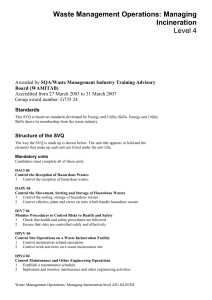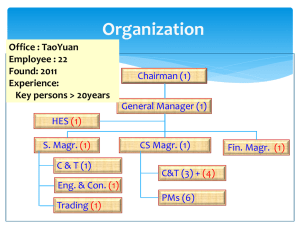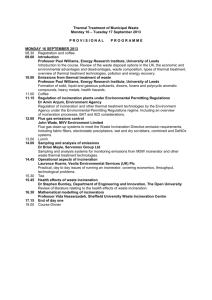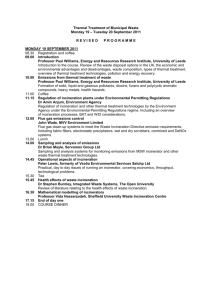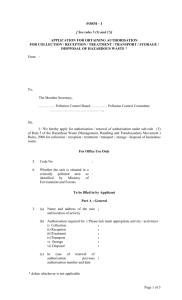Chapter 6.5 Thermal treatment
advertisement
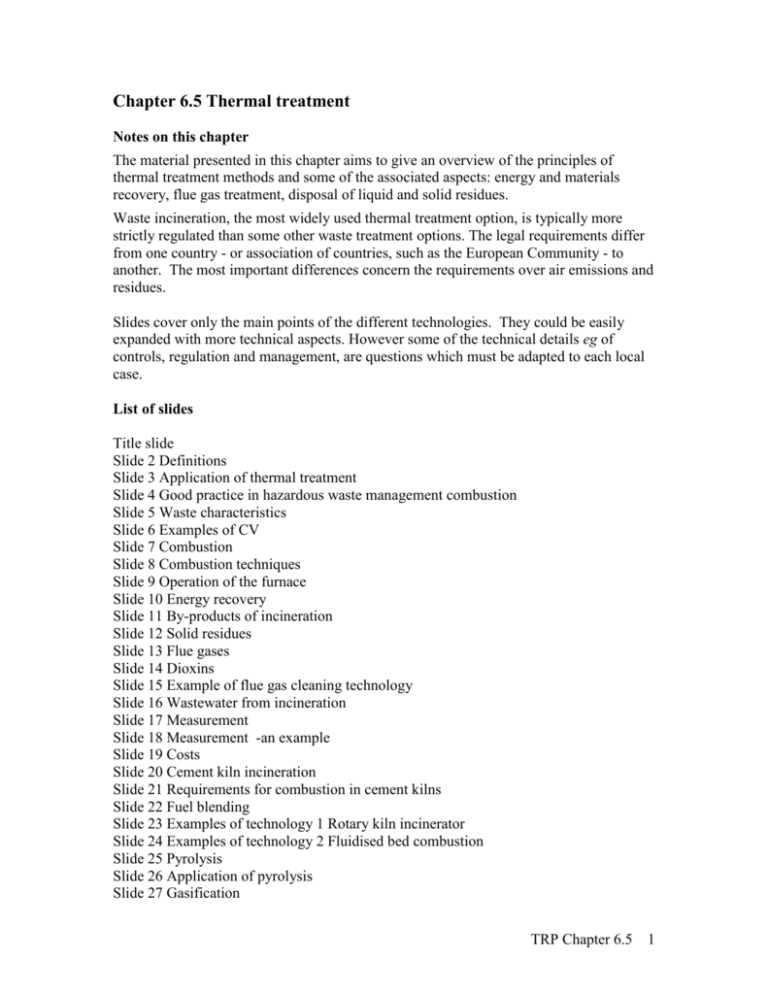
Chapter 6.5 Thermal treatment Notes on this chapter The material presented in this chapter aims to give an overview of the principles of thermal treatment methods and some of the associated aspects: energy and materials recovery, flue gas treatment, disposal of liquid and solid residues. Waste incineration, the most widely used thermal treatment option, is typically more strictly regulated than some other waste treatment options. The legal requirements differ from one country - or association of countries, such as the European Community - to another. The most important differences concern the requirements over air emissions and residues. Slides cover only the main points of the different technologies. They could be easily expanded with more technical aspects. However some of the technical details eg of controls, regulation and management, are questions which must be adapted to each local case. List of slides Title slide Slide 2 Definitions Slide 3 Application of thermal treatment Slide 4 Good practice in hazardous waste management combustion Slide 5 Waste characteristics Slide 6 Examples of CV Slide 7 Combustion Slide 8 Combustion techniques Slide 9 Operation of the furnace Slide 10 Energy recovery Slide 11 By-products of incineration Slide 12 Solid residues Slide 13 Flue gases Slide 14 Dioxins Slide 15 Example of flue gas cleaning technology Slide 16 Wastewater from incineration Slide 17 Measurement Slide 18 Measurement -an example Slide 19 Costs Slide 20 Cement kiln incineration Slide 21 Requirements for combustion in cement kilns Slide 22 Fuel blending Slide 23 Examples of technology 1 Rotary kiln incinerator Slide 24 Examples of technology 2 Fluidised bed combustion Slide 25 Pyrolysis Slide 26 Application of pyrolysis Slide 27 Gasification TRP Chapter 6.5 1 Slide 28 Key considerations Slide 29 Summary Background notes 1 The technology for a number of thermal treatment techniques is well-developed and proven, and thermal processing of hazardous wastes is in common use around the world. 2 The main technologies are often differentiated from one another by the type of grate which is used in the process. Some technologies have been specifically developed to deal with a particular waste stream, while others can handle a broad range of waste types. 3 New thermal techniques are also being developed and refined, including some smaller scale options which may have value in future for hazardous wastes treatment in industrialising countries. 4 Typically thermal processes have higher capital costs than most other treatment methods, not least because of the high costs of gas cleaning systems which may represent one third of the cost of the facility. 5 The complexity of the technology requires skilled and trained personnel to specify, construct and operate the facilities. 6 The opportunity to recover materials, heat or energy from the combustion of wastes can reduce costs. The location of the facility, and its proximity to markets for heat or power, will dictate the recovery option. 7 There are a number of different industrial processes which use wastes as fuel, some for their energy content, others for their minerals or for a combination of the two. These include steel, glass and cement manufacture, but of these, cement kiln use is the most widely applied. 8 Because of the high levels of lime present in cement kilns, the acid components in the flue gases are absorbed, making the co-combustion of hazardous wastes an effective way of treating (ie neutralising) acidic flue gas emissions. Metals are fixed into the cement product. 9 High operating standards are crucial. Many countries now have stringent regulations covering the operation and monitoring of thermal treatment facilities, and enforcement of those regulations is an important part of the hazardous waste management system. 10 Some of the emissions of concern from thermal processes are extremely small, and their accurate measurement is very difficult. This includes dioxin emissions, which are often cited as an issue by opponents to incineration. Greenpeace has an international antiincineration campaign, based largely on the dioxin issue. Good combustion control and gas cleaning measures enable modern plants to meet very strict regulatory limits for TRP Chapter 6.5 2 dioxins as well as other pollutants. In Europe, dioxin emissions from a number of other industrial processes eg steel production, are believed to be far greater than those from modern well-managed waste incineration. 11 The benefits of thermal processing include the effectiveness of the process for reducing hazard from the wastes, the energy recovery opportunities and also the volume reduction, given the limited availability of permitted landfill space in some countries. Sources of further information Batstone, R; Smith, JE & Wilson, DC editors (1989) The safe disposal of hazardous wastes: The special needs and problems of developing countries World Bank, Washington, Technical paper No 93 Vol 3 ISBN 0-8213-1144-1 (available as pdf files from www.worldbank.org/publications/) Dean, RB & Wilson, DC (Editors) (1990) Adapting hazardous waste management to the needs of developing countries, Waste Management & Research Vol 8 No 2 Guyer, Howard H (1998) Industrial processes and waste stream management Wiley ISBN 0-4712-9984-7 LaGrega, MD; Buckingham, PL; Evans, JC & ERM Group (1994) Hazardous Waste Management McGraw Hill, New York ISBN 0-07-019552-8 Lohwongwatana, B; Soponkanaporn, T & Sophonsridsuk, A Industrial hazardous waste treatment facilities in Thailand Waste Management & Research Vol 8 No 2 Nash, JM; Cheung, B; Fung, CH; Lei PK, Mak, PW; Rootham, RC; Stokoe, MJ & Tong, R (1991) Control and treatment of hazardous (chemical) waste in Hong Kong Waste Management & Research Vol 9 No 3 Ravishankar, R (1990) Opportunities and constraints for cement kiln incineration in Malaysia, Waste Management & Research Vol 8 No 2 Santoleri, JJ, Theodore, L & Reynolds, J (2000) Introduction to hazardous waste incineration Wiley ISBN 0-4710-1790-6 Technical guidelines from the Secretariat of the Basel Convention www.basel.int TRP Chapter 6.5 3
